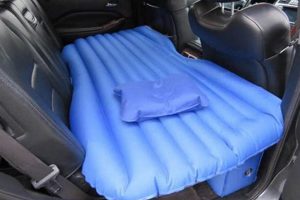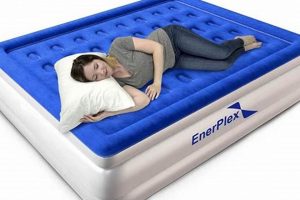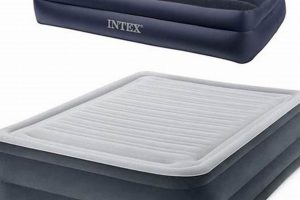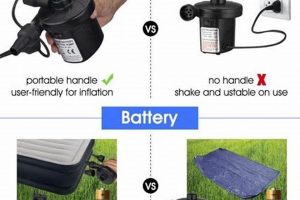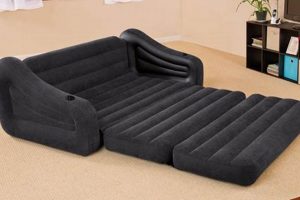Identifying the source of air leakage in an inflatable mattress is essential for maintaining its functionality and comfort. The process involves systematically examining the mattress to pinpoint the location where air is escaping. This often requires careful observation and methodical testing to detect subtle air currents.
Successfully locating the leak prevents further deflation and extends the lifespan of the air mattress. Addressing the issue promptly is beneficial, as it saves on replacement costs and ensures the mattress remains a viable sleeping surface. Historically, various methods have been employed, ranging from auditory detection to using soapy water solutions, to effectively find these breaches.
The subsequent sections will detail proven methods for detecting these leaks, providing a step-by-step guide to ensure efficient and accurate identification of the compromised area.
Techniques for Leak Detection in Air Mattresses
Effective leak detection hinges on systematic examination and the application of appropriate methods. The following techniques provide a structured approach to identifying punctures or weakened seams in air mattresses.
Tip 1: Auditory Inspection. Prior to any other methods, inflate the mattress fully in a quiet environment. Listen closely, moving the ear around the mattress surface, particularly near seams and valves, in an attempt to locate the source of escaping air. A hissing sound can indicate the presence of a leak.
Tip 2: Visual Examination. Conduct a thorough visual inspection of the mattress. Pay close attention to areas that experience stress, such as seams, corners, and around the valve. Look for signs of wear, stretching, or small punctures.
Tip 3: Soapy Water Application. Mix a solution of mild dish soap and water. Apply the solution to small sections of the inflated mattress using a sponge or spray bottle. Bubbles will form at the location of the leak as air escapes through the soapy film.
Tip 4: Submersion Method. If the mattress is small enough, submerge it partially in water, applying pressure to different sections. Observe the water for the appearance of air bubbles, which will pinpoint the leak’s location. Ensure the valve is securely closed during submersion.
Tip 5: Pressure Test. Inflate the mattress to its maximum recommended pressure and mark its outline. After a set period (e.g., 12-24 hours), observe the mattress for any significant deflation. If the mattress has noticeably deflated, a leak is likely present, even if its exact location has not yet been found.
Tip 6: Blacklight Inspection. In darkened conditions, use an ultraviolet (UV) light to examine the mattress. Certain leak-sealant products contain fluorescent dyes, which become visible under UV light, indicating previously attempted repairs or potential leak areas.
These methods, when applied diligently, significantly improve the probability of accurately detecting leaks in air mattresses, allowing for effective repair and prolonged use.
The subsequent section will focus on repair strategies for identified leaks.
1. Auditory detection
Auditory detection serves as a primary and often initial step in locating leaks in an air mattress. The process exploits the physics of air escaping under pressure; a puncture, however small, will generate an audible hissing or whistling sound. In a quiet environment, the escaping air becomes more readily discernible, allowing for a coarse localization of the leak before employing more refined techniques. This is a non-invasive method, requiring no external substances initially, and can quickly identify larger, more obvious perforations. For example, a sharp object causing a significant tear will typically produce a distinct hissing, easily detected by a careful listener.
The effectiveness of auditory detection is contingent on the ambient noise level and the size of the leak. A smaller puncture might produce a faint sound, necessitating a very quiet environment for accurate detection. Furthermore, the ability to differentiate between background noise and the specific sound of escaping air is crucial. Experience in identifying such sounds enhances the probability of successful leak detection. In practical application, this method involves slowly moving one’s ear close to the mattress surface, paying particular attention to seams, valves, and areas prone to wear or stress. Real-world application of this technique often reveals that a leak near a seam, where multiple layers of material converge, is more easily audible than a puncture in the middle of a flat surface.
In summary, auditory detection is a valuable initial tool in the process of finding an air leak. While not foolproof, its simplicity and non-destructive nature make it a practical first step. The information gathered can significantly narrow the search area, leading to more efficient application of subsequent methods, such as the soapy water test. The challenge lies in differentiating the sound of escaping air from ambient noise, but with practice and a quiet environment, it can be an effective diagnostic technique.
2. Visual inspection
Visual inspection constitutes a fundamental stage in the systematic process of identifying punctures or leaks in air mattresses. The process entails a careful, comprehensive examination of the mattress surface to identify physical anomalies indicative of potential air escape points. These anomalies may manifest as small punctures, tears, abrasions, or separations along seams. Effective visual inspection necessitates adequate lighting and meticulous observation to discern subtle imperfections that may otherwise be overlooked.
The importance of visual inspection is underscored by its ability to detect larger, more obvious punctures that might be missed by less direct methods, such as auditory detection. For instance, a puncture caused by a sharp object or a tear resulting from excessive stress is often immediately apparent upon visual examination. Additionally, visual inspection allows for the identification of areas exhibiting wear or potential weakness, such as stretched or faded areas of the material, which may be precursors to future leaks. The effectiveness of subsequent leak detection methods, such as the soapy water test, is enhanced by an initial visual assessment that narrows the potential search area.
In summary, visual inspection represents a crucial first step in the overall endeavor of detecting leaks in air mattresses. While it may not reveal every puncture, its capacity to identify readily apparent damage and to highlight areas of potential weakness significantly increases the efficiency and effectiveness of subsequent leak detection efforts. Its simplicity and non-destructive nature make it a valuable component of a comprehensive leak detection strategy
, contributing to the overall longevity and usability of the air mattress.
3. Soapy water test
The soapy water test is a common and effective technique employed to pinpoint the precise location of air leaks in an inflatable mattress. Its relevance stems from its capacity to visualize escaping air, thereby facilitating the accurate identification of punctures or compromised seams.
- Bubble Formation Mechanics
The test functions by exploiting the surface tension of soapy water. When applied to an inflated mattress, the solution forms a thin film. Escaping air from a leak disrupts this film, creating visible bubbles. The location of these bubbles directly corresponds to the position of the air leak. This provides immediate visual confirmation not obtainable through auditory or visual inspection alone.
- Solution Preparation and Application
Optimal execution of the soapy water test involves using a mild dish soap diluted in water. Excessive soap concentration can lead to inaccurate results, while insufficient concentration may not produce discernible bubbles. Application methods vary from sponges to spray bottles, with the latter providing a more even and controlled distribution of the solution across the mattress surface. Applying the solution in sections ensures that smaller leaks are not overlooked.
- Identifying Micro-Leaks
The soapy water test excels in detecting small punctures or micro-leaks, which are often imperceptible through other methods. These micro-leaks, while seemingly insignificant, can contribute to gradual deflation over time. The test’s sensitivity is particularly valuable in prolonging the lifespan of the air mattress, as early detection and repair of these small breaches prevent further deterioration.
- Post-Test Cleaning and Drying
After the leak is identified, it is crucial to thoroughly clean and dry the area to ensure proper adhesion of patching materials. Residual soap can interfere with adhesive bonds, compromising the integrity of the repair. Using a clean, dry cloth to remove all traces of the soapy solution is essential before proceeding with the patching process.
Collectively, the principles and application of the soapy water test provide a reliable method for detecting and localizing leaks in air mattresses. By visualizing escaping air, this technique empowers individuals to accurately identify and address punctures, contributing to the sustained performance and usability of the inflatable mattress.
4. Submersion method
The submersion method provides a direct approach to locating leaks in air mattresses, particularly when smaller punctures are suspected. Its effectiveness arises from the principle of displacement: submerging the inflated mattress in water forces air to escape from any breach, manifesting as a stream of bubbles. This visual cue pinpoints the leak’s location with a high degree of accuracy, a crucial step within the overarching process of identifying air leaks in mattresses.
The utility of the submersion method is most pronounced when dealing with leaks that are difficult to detect through auditory or visual inspection alone. Smaller punctures, or those situated in less accessible areas like seams, may not produce a distinct sound or be readily visible. A common example involves slow leaks caused by pinholes. Without submersion, identifying these subtle leaks becomes significantly more challenging, often requiring repeated inflation and monitoring over extended periods. Submersion provides immediate and unequivocal evidence of such leaks.
The submersion method, while effective, presents limitations. Its applicability is primarily restricted to smaller mattresses or sections thereof, as maneuvering a large, inflated mattress within a water-filled container can be cumbersome. However, when feasible, it serves as a highly reliable means of precisely locating leaks, enabling efficient and targeted repairs, thereby contributing significantly to extending the lifespan of the air mattress. The accuracy and directness of this method make it a valuable component in a comprehensive leak detection strategy.
5. Pressure monitoring
Pressure monitoring serves as a valuable diagnostic tool within the broader process of identifying leaks in air mattresses. It operates on the principle that a sealed, inflated air mattress should maintain a relatively constant internal pressure over a defined period. A decrease in pressure indicates an air leak, whether from a puncture, compromised seam, or faulty valve. The rate of pressure loss can provide insights into the size or severity of the leak.
The practical application of pressure monitoring involves inflating the mattress to its recommended pressure and then observing its firmness over several hours. The initial pressure should be measured using a pressure gauge or by marking the mattress outline and checking for deflation beyond that mark. If the mattress noticeably deflates, a leak is confirmed, even if its location is not immediately apparent. For instance, an air mattress used nightly that requires increasingly frequent re-inflation is indicative of a developing leak that pressure monitoring can help identify.
Pressure monitoring, while not pinpointing the exact leak location, offers a definitive confirmation of its existence. It functions as a preliminary step, guiding subsequent leak detection methods such as the soapy water test or submersion. Integrating pressure monitoring into the diagnostic process enhances the efficiency of finding the source of air leakage, contributing to prolonged mattress lifespan and sustained user comfort.
Frequently Asked Questions
This section addresses common inquiries regarding the identification of air leaks in inflatable mattresses, offering clear and concise information to assist in effective troubleshooting.
Question 1: How long should an air mattress hold air without noticeable deflation?
A properly sealed air mattress should maintain its inflation level for at least 24 hours with minimal pressure loss. A gradual reduction in firmness may occur due to temperature fluctuations, but significant deflation within this timeframe strongly suggests the presence of a leak.
Question 2: Is it possible to detect a very small leak in an air mattress?
Minute leaks, often referred to as pinhole leaks, can be challenging to detect. The submersion method or a meticulous application of soapy water is recommended to identify these subtle breaches.
Question 3: What areas of an air mattress are most prone to leaks?
Seams, corners, and areas surrounding the inflation valve are typically the most susceptible to leaks due to stress and friction. These areas should be inspected with particular care during the leak detection process.
Question 4: Can temperature affect air mattress inflation and potentially mimic a leak?
Yes, significant temperature drops can cause a decrease in air pressure within the mattress, leading to a perceived deflation. It is recommended
to check the mattress in a stable temperature environment before concluding that a leak exists.
Question 5: Are there any specific tools recommended for leak detection?
A spray bottle for applying soapy water, a basin for submersion testing (if the mattress size permits), and adequate lighting are valuable tools. No specialized equipment is required for basic leak detection.
Question 6: What is the best method to mark a detected leak for repair?
A permanent marker can be used to clearly mark the location of the leak once it has been identified. This will aid in the precise application of patching materials during the repair process.
Effective identification and resolution of leaks contribute to the longevity and optimal performance of air mattresses.
The subsequent section will cover methods for the effective repair of identified air mattress leaks.
Conclusion
The preceding sections have detailed a systematic approach to identifying air leaks in inflatable mattresses. From auditory and visual inspections to the application of soapy water, submersion techniques, and pressure monitoring, a comprehensive strategy is essential. Accurate leak detection necessitates a methodical application of these methods, ensuring a thorough examination of potential breach points.
The ability to locate leaks effectively is crucial for maintaining the functionality and longevity of air mattresses. Prompt identification allows for timely repair, preventing further damage and preserving the mattress’s usability. Proficiency in these techniques ensures a cost-effective and sustainable approach to air mattress maintenance, reducing the need for premature replacements.


